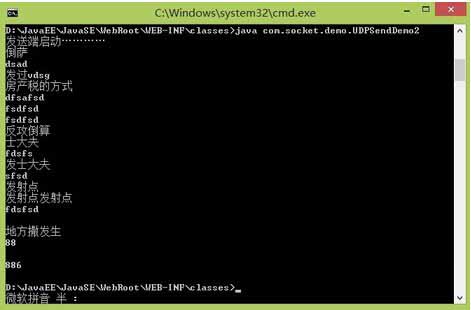Java的socket服务UDP协议
作者:网络转载 发布时间:[ 2016/1/4 11:04:47 ] 推荐标签:测试开发技术 编程语言
练习2
接收类:
package com.socket.demo;
import java.io.IOException;
import java.net.DatagramPacket;
import java.net.DatagramSocket;
public class UDPReceiveDemo2 {
public static void main(String[] args) throws IOException{
System.out.println("接收端启动…………");
/*
2、建立UDP的socket的服务,必须明白一个端口号
3、创建数据包,用于储存接收到的数据,方便用数据包对象的方法解析这些数据
4、使用DatagramSocket的receive方法将接收到的数据存储到数据包中
5、通过数据包的方法解析数据包中的数据
5、关闭socket服务
*/
//udpsocket服务。使用DatagramSocket对象
DatagramSocket ds=new DatagramSocket(10003);
while(true){
//使用DatagramPacket将数据封装到该对象中
byte[] buf=new byte[1024];
DatagramPacket dp=new DatagramPacket(buf, buf.length);
//通过udp的socket服务将数据包发送出去,通过send方法
ds.receive(dp);//堵塞式的。
//通过数据包的方法解析数据包中的数据,比方,地址、端口、数据内容等
String ip=dp.getAddress().getHostAddress();
//String name=dp.getAddress().getHostName();
int port=dp.getPort();
String text=new String(dp.getData(),0,dp.getLength());
//System.out.println("-----"+ip+"-----"+name+"-----"+port+"-----"+text);
System.out.println("-----"+ip+"----------"+port+"-----"+text);
}
//关闭资源
//ds.close();
}
}
发送类:
package com.socket.demo;
import java.io.BufferedReader;
import java.io.IOException;
import java.io.InputStreamReader;
import java.net.DatagramPacket;
import java.net.DatagramSocket;
import java.net.InetAddress;
public class UDPSendDemo2 {
public static void main(String[] args) throws IOException{
System.out.println("发送端启动…………");
/*
* 1、创建udp传输的发送端
2、建立UDP的socket的服务
3、将要发送的数据封装到数据包中
4、通过udp的socket服务将数据包发送出去
5、关闭socket服务
*/
//udpsocket服务,使用DatagramSocket对象
DatagramSocket ds=new DatagramSocket(9999);//监听端口
//将要发送的数据封装到数据包中
//String str="udp传输演示。go";
BufferedReader bufr=new BufferedReader(new InputStreamReader(System.in));//键盘输入
String line=null;
//使用DatagramPacket将数据封装到该对象中
while((line=bufr.readLine())!=null){
byte[] buf=line.getBytes();//
DatagramPacket dp=
new DatagramPacket(buf, buf.length,InetAddress.getByName("192.168.1.100"),10003);
//通过udp的socket服务将数据包发送出去。通过send方法
ds.send(dp);
if("886".equals(line)){
break;
}
}
//关闭资源
ds.close();
}
}
执行效果图:
接收

发送

本文内容不用于商业目的,如涉及知识产权问题,请权利人联系SPASVO小编(021-61079698-8054),我们将立即处理,马上删除。
相关推荐
Java性能测试有哪些不为众人所知的原则?Java设计模式??装饰者模式谈谈Java中遍历Map的几种方法Java Web入门必知你需要理解的Java反射机制知识总结编写更好的Java单元测试的7个技巧编程常用的几种时间戳转换(java .net 数据库)适合Java开发者学习的Python入门教程Java webdriver如何获取浏览器新窗口中的元素?Java重写与重载(区别与用途)Java变量的分类与初始化JavaScript有这几种测试分类Java有哪四个核心技术?给 Java开发者的10个大数据工具和框架Java中几个常用设计模式汇总java生态圈常用技术框架、开源中间件,系统架构及经典案例等

更新发布
功能测试和接口测试的区别
2023/3/23 14:23:39如何写好测试用例文档
2023/3/22 16:17:39常用的选择回归测试的方式有哪些?
2022/6/14 16:14:27测试流程中需要重点把关几个过程?
2021/10/18 15:37:44性能测试的七种方法
2021/9/17 15:19:29全链路压测优化思路
2021/9/14 15:42:25性能测试流程浅谈
2021/5/28 17:25:47常见的APP性能测试指标
2021/5/8 17:01:11热门文章
常见的移动App Bug??崩溃的测试用例设计如何用Jmeter做压力测试QC使用说明APP压力测试入门教程移动app测试中的主要问题jenkins+testng+ant+webdriver持续集成测试使用JMeter进行HTTP负载测试Selenium 2.0 WebDriver 使用指南














 sales@spasvo.com
sales@spasvo.com